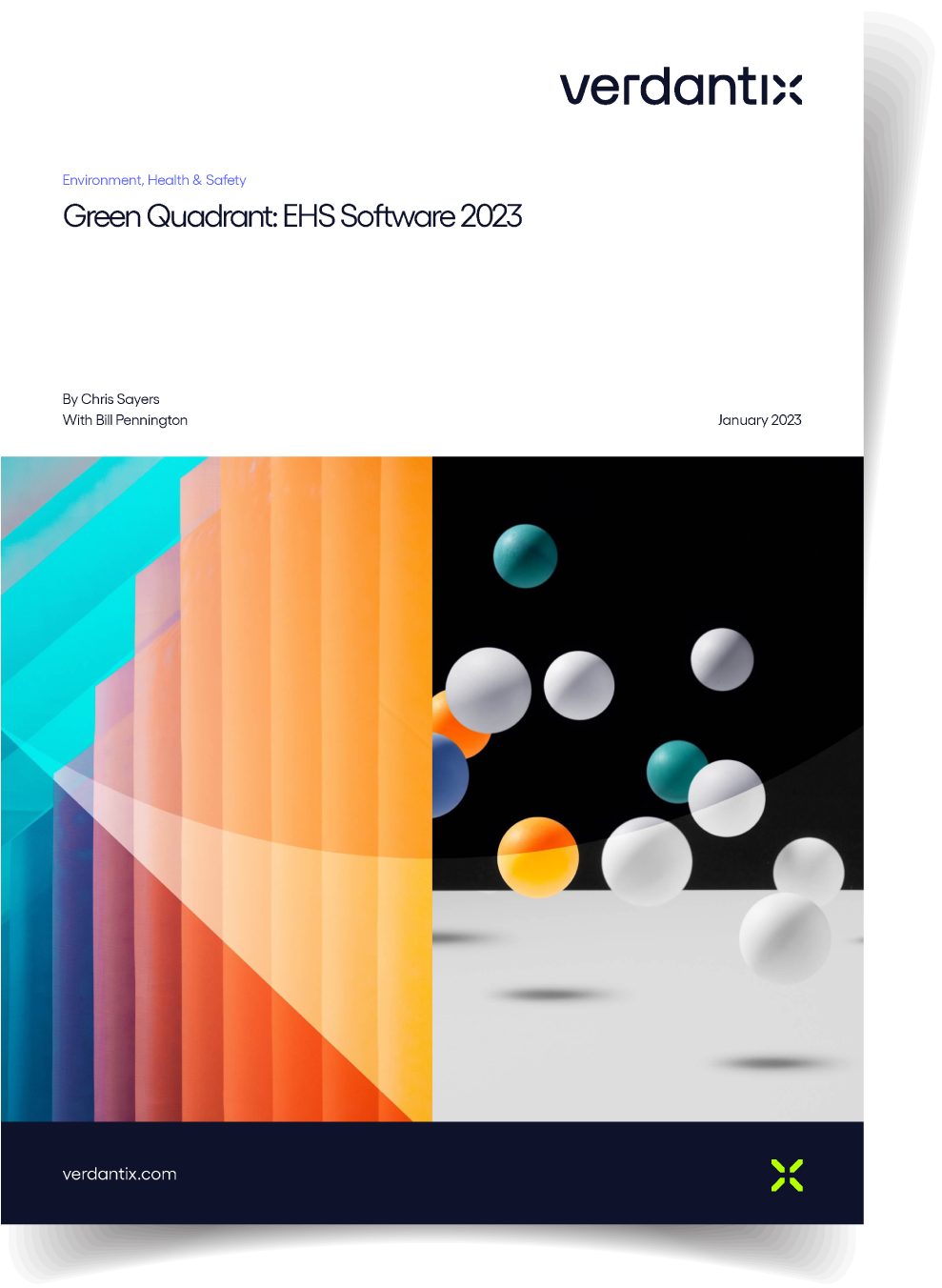With the growing interest in environmental, social, and governance (ESG) goals, the environment, health and safety (EHS) software market is responding with a focus on expanding into ESG and sustainability. EHS software is being shaped by the need to facilitate zero-incident rates and broaden worker health management, while also addressing the wider ESG landscape, including the increasing need to manage and report on a company’s net-zero emissions performance.
The Green Quadrant for EHS Software Report 2023 from independent research firm Verdantix provides a comprehensive examination of the EHS software market, evaluating firms based on robust selection criteria. The report named Sphera as a market leader that offers environmental excellence through its EHS and Sustainability Management Platform. Below, we examine the critical capabilities highlighted in the report.

Sphera was awarded the highest score among 23 vendors assessed for ESG and sustainability management for supporting target-setting at various organizational levels, sustainability program management and advanced forecasting and trend-finding. Sphera also received a perfect score for its offering that facilitates data collection and data checks for Scope 1, 2, and 3 emissions, as well as the top score for air emissions management. Broadly, Sphera’s solution design and capabilities go beyond ESG and sustainability compliance and reporting to help companies achieve transformational performance improvement. Key features help companies operate within the ever more dynamic sustainability environment and can help future-oriented companies as they meet increasingly complex demands for sustainability reporting. Download the report
ESG and Sustainability Management
SpheraCloud Corporate Sustainability Software helps organizations create and manage a portfolio of actions and projects to improve ESG performance. Agreed-upon targets (environmental, social, governance, financial, etc.) can be tracked against any metric, and the mitigation actions required to achieve each target can be analyzed from a financial and risk perspective to inform decisions. The solution allows organizations to respond in a coordinated, efficient manner by enabling them to define, plan, assess and track objectives at any level of the organizational hierarchy – applying the same detailed scenario analysis. Analytics provide feedback for tracking performance against targets with multiple scenarios – for example, Science-Based Targets based on a scenario of “Well Below 2 Degrees C”. Financial information related to actions (renewable energy procurement, deployment of low carbon technologies, supplier engagement, circular economy product design, etc.) can be captured and analyzed to identify the combination of actions that ensure targets are met and optimal ROI is achieved.
Advanced forecasting helps predict KPI performance at any point in the future. Automatically calculated linear trends can provide fast oversight of future performance. Regression analysis and scenario planning allow users to predict one parameter using several well-correlating proxies. For example, a user could predict energy consumption based on different production volumes or estimate electricity consumption based on heating degree days and occupancy rates. This analytical method can be applied to any resource, such as energy, waste, or water, and allows users to assess the payback of projects and compare energy forecasts to actual savings. In addition, the AI-powered trend finder can mine all available data to identify which parameters have a high correlation to the forecasted KPI (a wealth of net-zero performance metrics is available out of the box), helping users target the correct planning data to build their forecasts.
Sphera is accredited by the CDP (formerly known as the Carbon Disclosure Project) and certified by the Global Reporting Initiative (GRI). The software provides a report builder and customizable templates that streamline ESG reporting. These tools allow for data reuse, helping to save resources when responding to various reporting frameworks such as the Task Force on Climate-Related Financial Disclosures (TCFD).
GHG Emissions Management
Sphera received a perfect score of 3.0/3.0 for GHG management across Scope 1, 2 and 3 emissions. The software securely collects and stores Scope 1, 2 and 3 emissions data, offering an array of methods for data collection, including API integrations, Excel/CSV files and intuitive web forms with data simplification tools to ensure comprehensive GHG data collection. It enables companies to associate emissions quantities with specific operating assets (and legal entities); facilitates data audits and process reviews; and provides secure access for auditors that offers complete visibility into emissions calculation formulas, aggregations and consolidation.
Calculating your company’s GHG emissions baseline, including Scope 1, 2 and 3, often involves emission factors derived from disparate data sources. Often these sources use varying collection methods and update on different cycles. Our Corporate Sustainability software makes data access and integration easier, with consolidated, up-to-date emission factors embedded directly into the platform. Flexible, real-time analytics provide accurate GHG emissions calculations. Emission factor calculations are created within our business intelligence tool with high-performance technology based on big data analytics. Once new activity data or updated emission factors are loaded into the software, all related analytics are automatically recalculated. Sphera’s integrated impact libraries offer emission factors from external data sources such as Defra, IEA, EPA, IPCC and GHG Protocol, as well as Sphera LCA databases (GaBi), which are the largest, most comprehensive and consistent datasets available.
Air Emissions Management
Sphera was top among the 23 assessed vendors for air emissions management for its ability to meet regulatory demands across multiple jurisdictions. Environmental Accounting software offers permit management functionality integrated with compliance assurance, environmental management, incident management and chemicals inventory, allowing users to track permit limits, automatically assign tasks, and track permit changes and applicability. Air emissions management is enabled via a robust calculation engine and formula builder, supported by an expression analysis tool that allows users to see an expression visually, along with intermediate calculated values and the source of each parameter.
In addition, Health and Safety Management Software offers best-of-breed capabilities to improve employee safety, manage regulatory reporting of incidents and improve risk management across your company. The software provides complete risk visibility and end-to-end control of safety events and activities. To improve the safety culture and performance, the software helps define corrective actions, conduct audits, perform risk assessments, manage changes, initiate training and manage documentation to stay compliant with regulatory requirements and prevent future incidents.
Expansion of EHS into ESG and sustainability is a defining market trend over the past two years and is becoming increasingly important for companies as they evaluate their options to promote sustainable operations, responsible management and long-term value creation.
The Green Quadrant EHS 2023 report highlights Sphera’s track record of serving large multinational companies with a platform that offers functionality across environment, health and safety (EHS); environmental, social and governance (ESG); operational risk management (ORM); and product stewardship. To review the latest trends shaping the EHS software market and an assessment of Sphera’s EHS and sustainability management software, get your free copy of the report, Green Quadrant EHS Software 2023.

